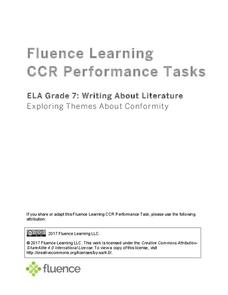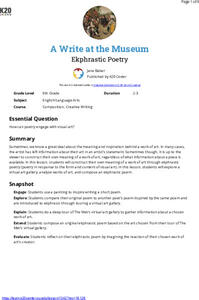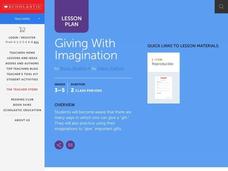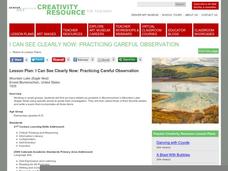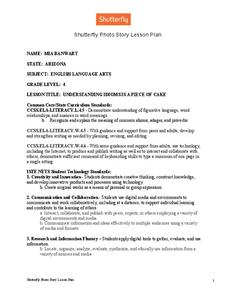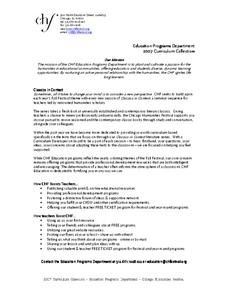Fluence Learning
Writing About Literature: Exploring Themes About Conformity
Feeling the pressure to confirm is something any adolescent can relate to. Explore an essential theme with a response to literature assessment that prompts learners to identify main ideas with evidence and supporting details.
MENSA Education & Research Foundation
Death Be Not Proud
Not dreadful, but mighty, this worksheet for “Divine Sonnet X” (aka “Death Be Not Proud”) models for individuals how to recognize John Donne’s argument for why Death should not be proud and how to recognize the sonnet structure and rhyme...
Louisiana Department of Education
Out of the Dust
The Grapes of Wrath may be the most famous novel set during the Dust Bowl, but what other stories cover the same time? The unit focuses on the Karen Hesse novel Out of the Dust. Learners keep a timeline of the Dust Bowl, maintain a...
K20 LEARN
A Write At The Museum: Ekphrastic Poetry
Which came first—the painting or the poem? In this case, it is the painting. Scholars closely examine a work of art and then craft an ekphrastic poem in response. A carefully scaffolded nine-page plan leads young poets through the process.
Curated OER
Lesson: That Long Jakes
Cross-media analysis takes time and attention to detail. The class analyzes the painting Long Jakes and the poem "Backward Bill." They pay attention to the similarities and differences in each piece, looking for details that describe the...
Curated OER
Lesson: Unfolding Water Lilies
Comparing two different artistic mediums can be a welcome challenge. Learners compare Monet's The Water Lily Pond to three nature-inspired poems. They consider how each art form is interrelated, descriptive, and expressive. They then...
Curated OER
Giving with Imagination
Demonstrate gift giving as an act of caring about someone versus gifts for show (or gifts from the purse). Elementary learners practice giving gifts from the heart by creating a poem for someone special to them.
Curated OER
Lesson: I Can See Clearly Now Practicing Careful Observation
Poetry and art analysis go hand-in-hand. In groups, youngsters analyze a landscape painting, making careful observations. They use details found in the painting to inspire an original poem. The poem must include at least three objects...
Shutterfly
Photo Story Lesson Plan
After reading Loree Leedy's There's a Frog in My Throat: 440 Animal Sayings a Little Bird Told Me, kids create and illustrate their own poems that convey the meaning of an idiom. The poems are then transferred into Shutterfly's Photo...
Curated OER
Lesson: Creating With A Purpose
Discovering the creative process can be done through critical analysis. Upper graders examine a hand -carved Shinto Deity, discussing purpose, technique, and artistic expression. They then read a poem about the creative process. and...
Curated OER
Lesson: Expressing the Inner Life of Things
Found metal objects were welded together to create an inspiring African sculpture. Learners consider the use of objects and the inspiration of African art seen in Picasso's work. They then find and create a scrap art sculpture, as well...
Curated OER
Lesson: One of These Things is Not Like the Other
Kids kick of the lesson plan by comparing and contrasting the focus painting to other similar paintings of Native American women. They then compare their own personal portraits (photographs) in a similar way. They use the differences in...
Novelinks
The Chosen: Biopoem
What better way to get to know a character than through a biopoem? Learners choose a character from Chaim Potok's The Chosen and create a well-crafted poem about his or her desires, traits, and ambitions.
Curated OER
"Feathers"
Students examine the character traits of kindness and responsibility using the book "Feathers" by Heather Forest. They play a "Mystery Bag" game with feathers, and answer story comprehension questions. Students then complete an acrostic...
Read Works
Spring
Celebrate the season of spring with a poem. After reading a four-stanza poem about the season, sixth grade readers respond to 10 reading comprehension questions that have them thinking about the purpose, imagery, and other types of...
Curated OER
Acronyms--Characters in The Hobbit
Have your class create acrostic poems for characters in The Hobbit. First, define acronyms and work together to complete sample acronyms for their own first names. Learners then research specific characters in the novel and create...
Curated OER
Lesson: Living For The City
Both Money and Cummings were able to capture the essence of Paris. Critical thinkers analyze how each artist used his medium to describe the same place in a different way. Kids then write a Cummings-style poem about Monet's Waterloo Bridge.
Curated OER
Writing and Autobiography
Are you working on an autobiographical or narrative writing unit? Bring this lesson to your class, as it takes young writers through the process of drafting and sequencing an autobiography. After observing and demonstrating steps of the...
Curated OER
Beowulf
High schoolers complete literature analysis activities for Beowulf. They read lines from the poem and complete character analysis activities. In addition, they write and share a boast modeled on the text and then create heroes and...
Curated OER
Homer’s Odyssey Reading Guide
Looking for a list of reading questions to use with The Odyssey? Provided here are dozens of questions (although certain sections are left out). Use these questions to create your own reading guide for the famous epic poem.
School District No. 71
Adding Written Detail: Using Jane Yolen’s Owl Moon as a Mentor Text
Access your senses with a worksheet on sensory language. Based on Owl Moon by Jane Yolen, the worksheet prompts kids to find examples of each of the five senses, as well as phrases for inner emotion.
Curated OER
My Antonia: Biopoem Writing Strategy
Explore the characters in My Antonia by Willa Cather with a biopoem assignment. Pupils use the provided format to write their poems about any character from the book.
Roald Dahl
Matilda - The Weekly Test
Readers take the main characters in Matilda and individually describe them through a mnemonic. To get there, group members create an acrostic poem describing the character they were given, and choose one of the words from the acrostic...
Roald Dahl
The Twits - Mrs Twit
"A person who has good thoughts cannot ever be ugly." The second lesson in an 11-part unit that accompanies The Twits by Roald Dahl uses poetry to encourage positive character traits. Mrs. Twit has ugly thoughts, but those thoughts can...


